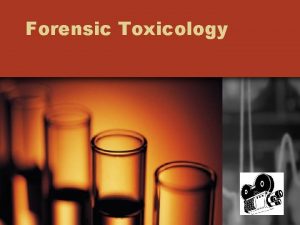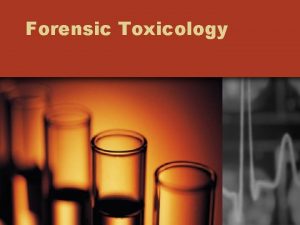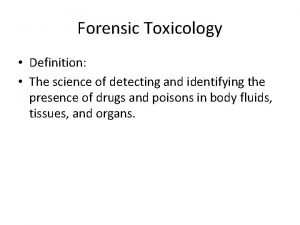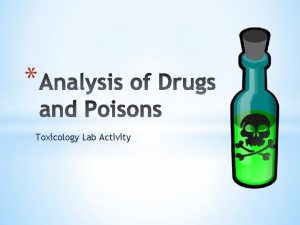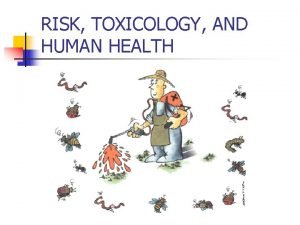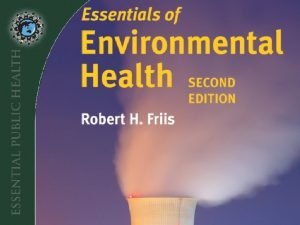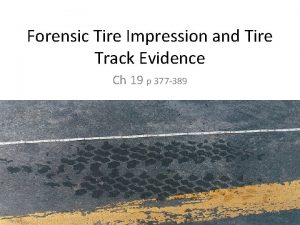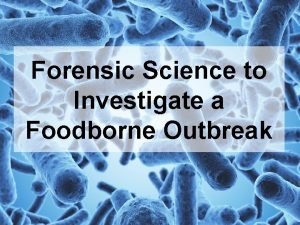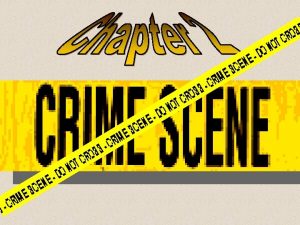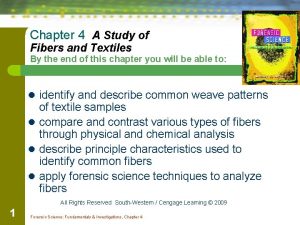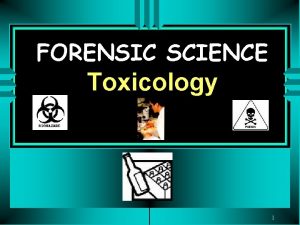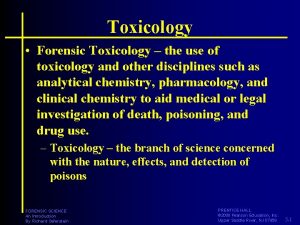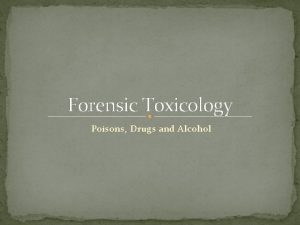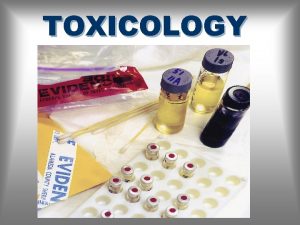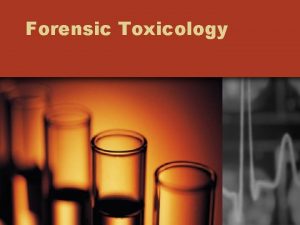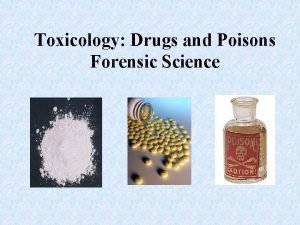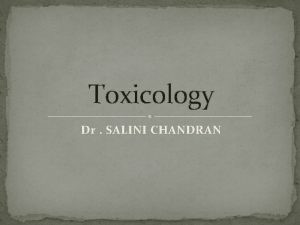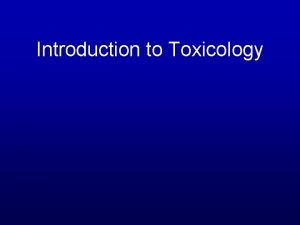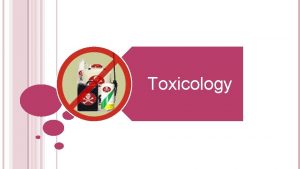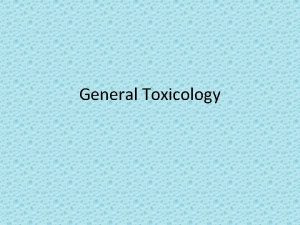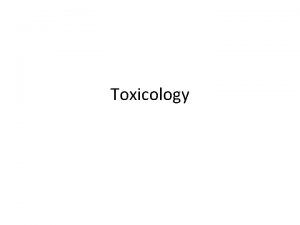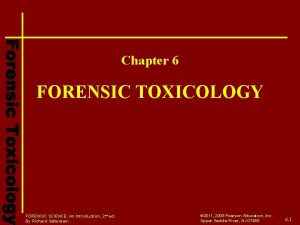Forensic Toxicology Forensic Toxicology Definition The science of

















































- Slides: 49

Forensic Toxicology

Forensic Toxicology • Definition: • The science of detecting and identifying the presence of drugs and poisons in body fluids, tissues, and organs for the purpose of determining their influence on human behavior. • a. needed to devise rapid and specific procedures for measuring the degree of alcohol intoxication. .

The Drug Recognition Expert • 3 -5 month training program for a police officer certifies an officer as a DRE. • The toxicologist can determine that a suspect has a certain drug in their body, but they often cannot infer with reasonable certainty that the suspect was impaired at a specific time. • The DRE evaluation process can suggest the presence of the following seven broad categories of drugs as well as determine the level of impairment: • depressants • stimulants • hallucinogens • phencyclidine • inhalants • narcotic analgesics • cannabis

Controlled Substances Act • Federal Law established 5 schedules of classification of controlled substances based on – Drug’s potential for abuse – Potential to physical and psychological dependence – Medical Value • Note: Federal law also controls materials that are used in making drugs and those that are manufactured to resemble drugs

Drug Schedules • Schedule I: • Drugs with high potential for abuse and addiction, NO medical value Ex: Heroin, LSD, Ecstasy, Marijuana • Schedule II: • Drugs with high potential for abuse and addiction, have some medical value with restrictions Ex: PCP, Cocaine, Amphetamines, Most Opiates, Some Barbiturates

Drug Schedules • Schedule III: • Drugs with less potential for abuse and addiction, currently acceptable for medical use Ex: Some Barbiturates, Codeine, Steroids • Schedule IV: • Drugs with low potential for abuse and addiction, currently acceptable for medical use Ex: Tranquilizers like Valium, Xanax, Librium

Drug Schedules • Schedule V: • Drugs with low potential abuse, medical use, lowest potential dependency • Ex: Some Opiates with Non-Narcotic Ingredients

Role of the Toxicologist • Must identify one of thousands of drugs and poisons • Must find nanogram to microgram quantities dissipated throughout the entire body • Not always looking for exact chemicals, but metabolites of desired chemicals (ex. heroin morphine within seconds)

• Toxicologist examines organs and/or body fluids (usually blood and urine) for the presence of drugs and poisons. • a. clues are sometimes available from the victim’s symptoms or from empty drug containers or house hold chemicals or from evidence found on the victim’s personal effects.

• After the toxicologist detects, identifies, and quantifies a drug or poison, they must be prepared to assess the substances toxicity. • Toxicologist is directly dependent on input from the attending physician, the medical examiner, and police officers. • once the drug has been found and identified, the toxicologist needs to assess its influence on the behavior of the individual. Factors that need to be considered include • age • physical condition • tolerance of the drug user • additive or synergistic effects provided by the interaction of 2 or more drugs Ex. Alcohol and barbiturates or narcotics are potentially lethal combinations. • observations of the arresting officer or of the medical examiner if the person is deceased

Toxicology Procedures • 10 m. L of blood in airtight container – – Add anticoagulant (EDTA) Add preservative (sodium fluoride) Refrigerate Analyze quickly! • 2 consecutive urine samples – Some drugs take a while to show up in urine (1 -3 days) • Vitreous humor • Hair samples

Toxicology Procedures • Alcohol and cocaine normally account for 90% or more of the drugs encountered in a typical toxicology lab. • toxicologist must devise an analytical scheme that will detect, isolate and specifically identify a toxic substance. • a. selectively removes and isolates drugs and other toxic agents from the biological materials submitted as evidence. • b. determines if the drug is an acid or a base. • acid drugs are easily extracted an acidified water solution. Basic drugs are removed from a basic water solution.

More Analytical Tests • screening tests are then performed – immunoassay- based on specific drug antibody reactions, able to detect minute amounts of drugs in body fluids and organs. – gas chromatography – thin layer chromatography • confirmation tests are done last. – gas chromatography- mass spectrometry- first the drug mixture is separated by gas chromatography, then the separated components enter the mass spectrometer which bombards the gas with high energy electrons. The gas components break into fragments and a fragmentation pattern (mass spectrum) for each gas in the sample is made. A unique fingerprint of the components in the drug mixture is created this way. Creates a fingerprint for the drug

More Analytical Tests • examples of applications • urine testing for drugs by the military • heavy metal poison detection- heavy metals include arsenic, antimony, bismuth, mercury, and thallium. • Reinsch test- dissolve suspected body fluid or tissue in hydrochloric acid and then insert a copper strip into the solution. The appearance of a silvery or dark coating on the copper indicates the presence of a heavy metal. • application of an analytical technique for determining inorganic compounds.

More Analytical Tests • Carbon monoxide poison detection- 2 basic methods-spectrophometric methods- examine the visible spectrum of blood to determine the relative amounts of carboxyhemoglobin to oxyhemoglobin or total hemoglobin. -gas chromatography- blood is treated with a reagent that liberates the carbon monoxide and then the CO amount is determined using gas chromatography. -Inhalation of CO fumes is a common way to commit suicide. -Level of CO in the blood of a victim found at the scene of a fire is used to determine if foul play has occurred. If the victim has high levels of CO in the blood, this proves that the victim breathed the combustion products of the fire and was therefore alive when the fire began. Many attempts at covering up a murder by setting fire to the victim’s house or car have been uncovered in this manner.

Carbon Monoxide Poisoning

Why? • Think of all the people that you have “heard” do drugs. • US drug manufacturers produce enough barbiturates and tranquilizers each year to give every person in the US 40 pills • (that’s about 12 billion pills) • 18, 000 out of 44, 000 annual traffic deaths are alcohol related and send over 2 million people to the hospital

Toxicology of Alcohol • Alcohol is absorbed through the stomach and intestine • Once absorbed, alcohol is: – Oxidized- (95 -98%) in liver by alcohol dehydrogenase—turned into carbon dioxide and water – Excreted- (3 -5%) by breath, perspiration, and kidneys— eliminated unchanged. Amount of alcohol in breath is directly proportional to concentration of alcohol in blood (Brain)

Factors that Affect Alcohol Absorption • Time of consumption • Type of alcoholic beverage • Presence of food in stomach • Amount of alcohol

Toxicology of Alcohol • Alcohol intoxication depends on – – Amount of alcohol consumed Time of consumption Body weight Rate of alcohol absorption blood-alcohol concentration may not be reached until 2 -3 hours have elapsed from the time of consumption. Normally however, it takes 30 -90 minutes from the time of the final drink until absorption is completed.

Fate of Alcohol • Alcohol is absorbed into the bloodstream • Distributed through-out the body’s water • And finally eliminated by oxidation and excretion

Fate of Alcohol Con’t Note: A. Oxidation is the combination of oxygen and alcohol to produce new products by the liver B. Elimination is removing alcohol from the body in an unchanged state; normally excreted in breath and urine Alcohol has its principle effect on the central nervous system in particular, the brain. Blood-alcohol concentration is directly proportional to the concentration of alcohol in the brain. (blood can be readily tested, brain tissue cannot)

Alcohol in the Circulatory System • Measuring the quantity of alcohol in the blood system determines the degree to which someone is drunk • Two methods of making this measurement – Measurement of alcohol content in blood – Measurement of alcohol in breath

Alcohol in the Circulatory System • 20% of alcohol is absorbed through the stomach wall into the portal vein. The rest of the alcohol is absorbed through h the small intestinal wall into the hepatic vein. Both veins carry the alcohol to the liver, where the process of alcohol destruction begins. • After the blood passes out of the liver, it travels to the heart and over to the lungs for gas exchange. As CO 2 leaves the blood and enters the alveoli, alcohol leaves too.

Circulation and Alcohol

Circulation and Alcohol

Circulation Definitions • Artery—a blood vessel that carries blood away from the heart • Vein—a blood vessel that transports blood toward the heart • Capillary—a tiny blood vessel—walls exchange materials between blood and tissues • Alveoli—small sacs in lungs—exchange vapors between breath and blood

Circulation Con’t • Note: If alcohol is present, it will be passed from the blood into the alveoli where it will be passed on to the mouth and nose during the act of breathing. • Henry’s Law applies here- When alcohol is dissolved in blood, and is brought to equilibrium with alveolar air, there is a fixed ratio between the concentration of the alcohol in air and its concentration in the blood, and this ratio is constant for a given temp. (At 34◦ C- 1 ml of blood will contain the same amount of alcohol as 2100 ml of alveolar

Circulation of Alcohol • After the blood leaves the lungs, it travels back to the heart and then to the through the arteries to the body, void of CO 2 and rich with O 2. • The arteries subdivide into capillaries where gas, nutrient and waste exchange occurs between the body cells and the blood. The capillaries rejoin to form veins which eventually lead back to the heart completing the cycle. • Concentration of alcohol in the arterial blood will be considerably higher than concentration of alcohol in the venous blood due to the rapid diffusion of alcohol into the body tissues from the venous blood during early stages of absorption.

Circulation of Alcohol • Blood tests for alcohol take blood from veins, which tend to have a lower alcohol content if the person is still in the absorptive stage. • Breath tests obtained during the absorptive phase reflect the alcohol concentration in the pulmonary artery and will show a greater alcohol content than results would show from analysis of venous blood. • Once absorption is complete the difference between a blood test and a breath test in terms of alcohol content are minimal.

Analysis of BAC • Breath Tests • Field Sobriety Tests • Blood Tests

Breath Tests • A breath test reflects the alcohol concentration in the pulmonary artery. • One instrument used for breath tests is called The Breathalyzer- developed in 1954 by R. F. Borkenstein • The Breathalyzer is a device for collecting and measuring the alcohol content of alveolar breath.

The Breathalyzer

• • When the valve is in the TAKE position, the subject is required to blow into a mouthpiece that leads into a metal cylinder. The pressure of the breath raises a piston. As the breath ends, the piston settles to a position that traps the last portion of air. When the valve is in the ANALYZE position, the piston drops causing the sample of air to pass into a glass ampoule that contains potassium dichromate and silver nitrate in sulfuric acid and water. Alcohol present will dissolve in the dichromate solution, and be oxidized to acetic acid. The potassium dichromate will be destroyed in the process making the solution clears. It is the amount of destruction of the potassium dichromate that is measured. This gives an indirect way of measuring the original amount of alcohol in the breath.

The Breathalyzer Con’t • The Breathalyzer traps 1/40 of 2100 milliliters of alveolar breath. • Since the amount of alcohol in 2100 milliliters of breath approximates the amount of alcohol in 1 milliliter of blood—the Breathalyzer in essence measures the alcohol concentration present in 1/40 of a milliliter of blood.

Breathalyzer Con’t • Once the alveolar breath is trapped it is allowed to undergo a chemical reaction: • 2 K 2 Cr 2 O 7 + 3 C 2 H 5 OH + 8 H 2 SO 4 2 Cr 2(SO 4)3 + 2 K 2 SO 4 + 3 CH 3 COOH + 11 H 2 O Potassium dichromate Ethyl alcohol Sulfuric acid Chromium sulfate Potassium sulfate Acetic acid water • The Breathalyzer is a simple spectrometer that indirectly determines the quantity of alcohol consumed by measuring the absorption of light by potassium chromate before and after its reaction with alcohol, using the principle of spectrophotometry

• • It is the amount of destruction of the potassium dichromate that is measured. This gives an indirect way of measuring the original amount of alcohol in the breath. The Breathalyzer is a simple spectrophotometer that indirectly measures the quantity of alcohol consumed by measuring the absorption of light passing through the potassium dichromate solution at a given wavelength before and after its reaction to alcohol.

Other Breath Tests • Infrared breath-testing instrument • Fuel cell • Note: These instruments are used more recently because they don’t depend upon chemical reagents and are entirely automated.

Infrared-Breath Test • Uses the principle that infrared light is absorbed when shined on alcohol • Essentially, the infrared light passes through a chamber where it will interact with the alcohol and cause the light density to decrease. • The decrease in light intensity is proportional to the concentration of alcohol present in the captured breath

Fuel Cell—Breath Test • A fuel cell converts a fuel and an oxidant into an electrical current. • In this test, the breath alcohol is the fuel and atmospheric oxygen acts as the oxidant. • Alcohol is converted, generating a current that is proportional to the quantity of alcohol present in the breath.

Infrared and Fuel Cell Breath Tests • Infrared Breath Test uses infrared wavelengths to test for alcohol or other interferences in the breath • Fuel Cell Test converts fuel (alcohol) and oxygen into a measurable electric current

Field Sobriety Testing • Two reasons for the field sobriety test: 1. Used as a preliminary test to ascertain the degree of the suspect’s physical impairment 2. To see whether or not an evidential test is justified.

Field Sobriety Testing Methods • Field sobriety testing consists of a series of psychophysical tests and a preliminary breath test (typically done with a handheld fuel cell tester) • These tests are preliminary and nonevidential in nature—they only serve to establish probable cause requiring a more thorough breath or blood test.

Field Sobriety Tests • Horizontal Gaze Nystagmus – Involuntary eye jerk as eye moves horizontally • Walk and Turn (divided attention tasks) • One-Leg Stand

Parts of the brain affected by Alcohol • Alcohol 1 st affects the forebrain and moves backward • Last affected is medulla oblongata

Alcohol and the Law • 1939 -1964: intoxicated = 0. 15% BAC • 1965: intoxicated = 0. 10% BAC • 2003: intoxicated = 0. 08% BAC • Driver has a choice of either submitting to a test for alcohol intoxication if requested, or be subject to loss of the license for a designated period, usually 6 months to one year. France, Germany, Ireland, or Japan (0. 05%) Sweden (0. 02%)

Alcohol and the Law • Try the drink wheel: http: //www. intox. com/wheel/drinkwheel. asp

Analysis of Blood for Alcohol • Gas chromatography- by comparing the resultant alcohol peak area to those obtained with known blood alcohol standards, the investigator can calculate the amount of alcohol in the blood with high accuracy

Collection and Preservation of Blood • Blood must be drawn under medically accepted conditions using a sterile needle or lancet and a nonalcoholic disinfectant. • Preservation is accomplished by sealing the blood in an airtight container after an anticoagulant (EDTA) and a preservative (sodium fluoride*) have been added. Specimen is then placed in a refrigerator. • Testing of blood should not be delayed as longer storage times reduce alcohol-blood levels.
 Forensic toxicology definition
Forensic toxicology definition A breath test reflects the alcohol concentration in the:
A breath test reflects the alcohol concentration in the: Definition of forensic toxicology
Definition of forensic toxicology Important people in forensic science
Important people in forensic science Forensic toxicology lab activity
Forensic toxicology lab activity Forensic toxicology vocabulary
Forensic toxicology vocabulary Favorite subject is science
Favorite subject is science What is forensic science
What is forensic science Deductive reasoning problem solving examples
Deductive reasoning problem solving examples Observation skills forensic science
Observation skills forensic science Forensic
Forensic Medulla forensic science definition
Medulla forensic science definition Deductive reasoning definition forensic science
Deductive reasoning definition forensic science Thomas mocker and thomas stewart
Thomas mocker and thomas stewart Forensic psychiatry vs forensic psychology
Forensic psychiatry vs forensic psychology Define environmental toxicology
Define environmental toxicology Toxicology definition
Toxicology definition Hegar's sign in pregnancy
Hegar's sign in pregnancy Keratin definition forensics
Keratin definition forensics Mass spectrometry in forensic science
Mass spectrometry in forensic science Branches of forensic science
Branches of forensic science Forensic science serial killers
Forensic science serial killers Tire track evidence
Tire track evidence Serology forensic science
Serology forensic science Locard's exchange principle
Locard's exchange principle Forensic science foodborne outbreak investigation answers
Forensic science foodborne outbreak investigation answers Forensic science begins at the crime scene.
Forensic science begins at the crime scene. Forensic science arson activity
Forensic science arson activity The golden book of camping
The golden book of camping Fibers from animals
Fibers from animals Classification of fibers
Classification of fibers Unscented trajectory chapter 17
Unscented trajectory chapter 17 Forensic anthropology unit
Forensic anthropology unit Branches of forensic science
Branches of forensic science Forensic photography management
Forensic photography management Forensic science ppt
Forensic science ppt Forensic science learning targets
Forensic science learning targets Department of forensic science dc
Department of forensic science dc Paul kirk forensic science
Paul kirk forensic science 1806 valentin ross
1806 valentin ross Forensic science weebly
Forensic science weebly Forensic science jobs
Forensic science jobs Unit 6 activity forensic science
Unit 6 activity forensic science Forensic science microscopes
Forensic science microscopes Transient evidence
Transient evidence Forensic
Forensic Edmond locard forensic science
Edmond locard forensic science Bow street runners definition
Bow street runners definition Glass forensic science
Glass forensic science What are the principles of fingerprint
What are the principles of fingerprint
